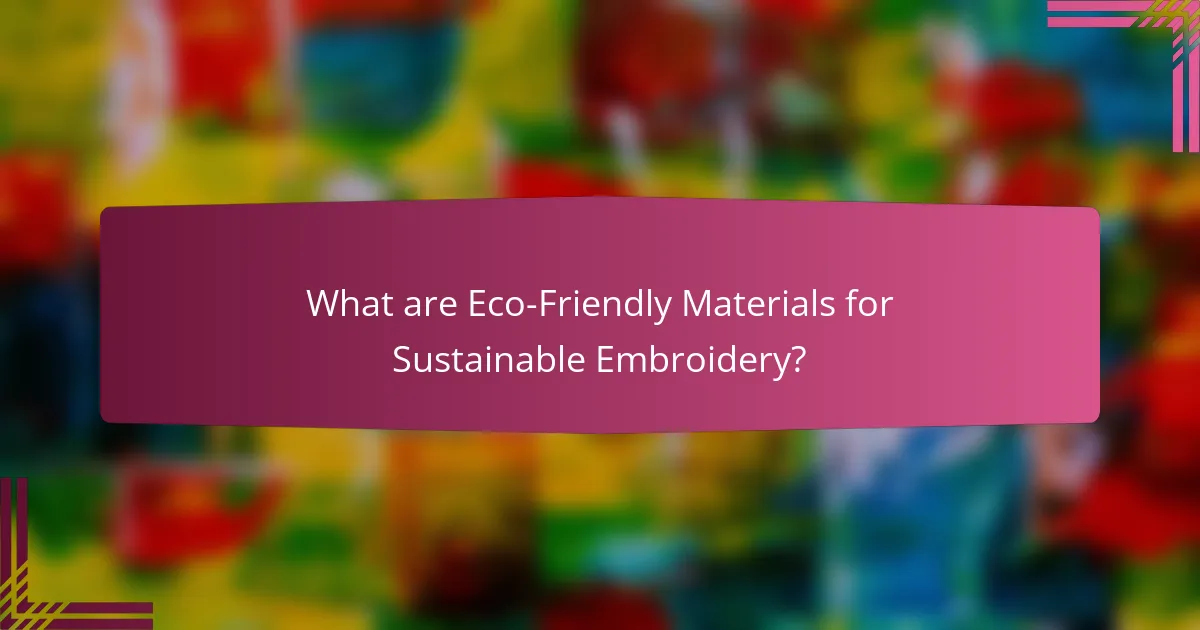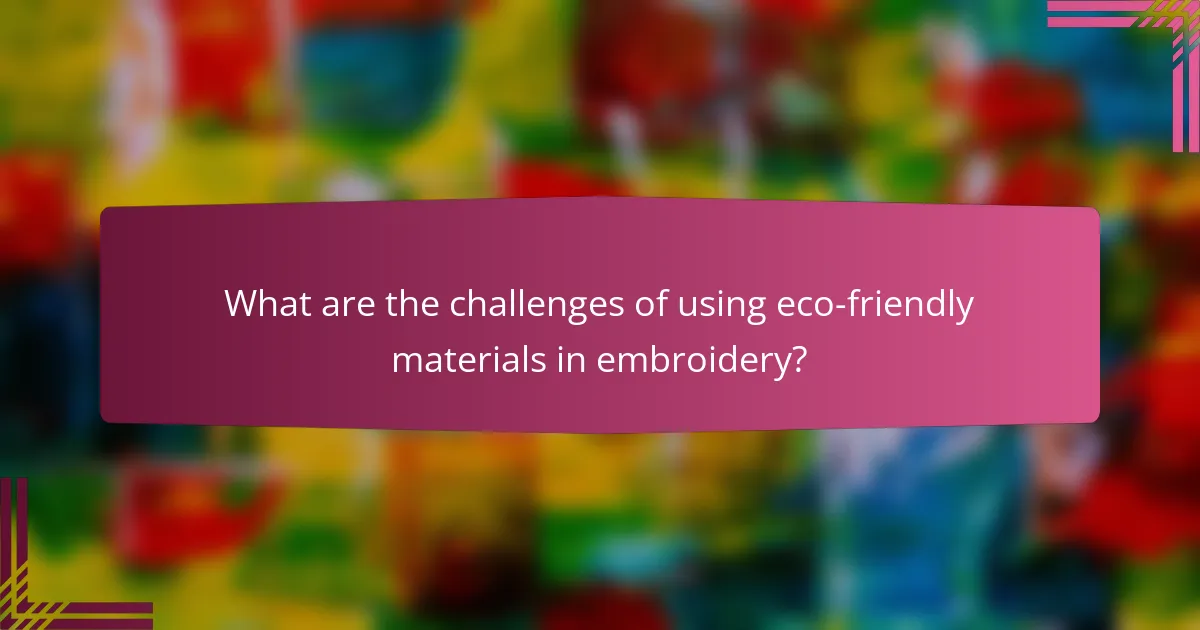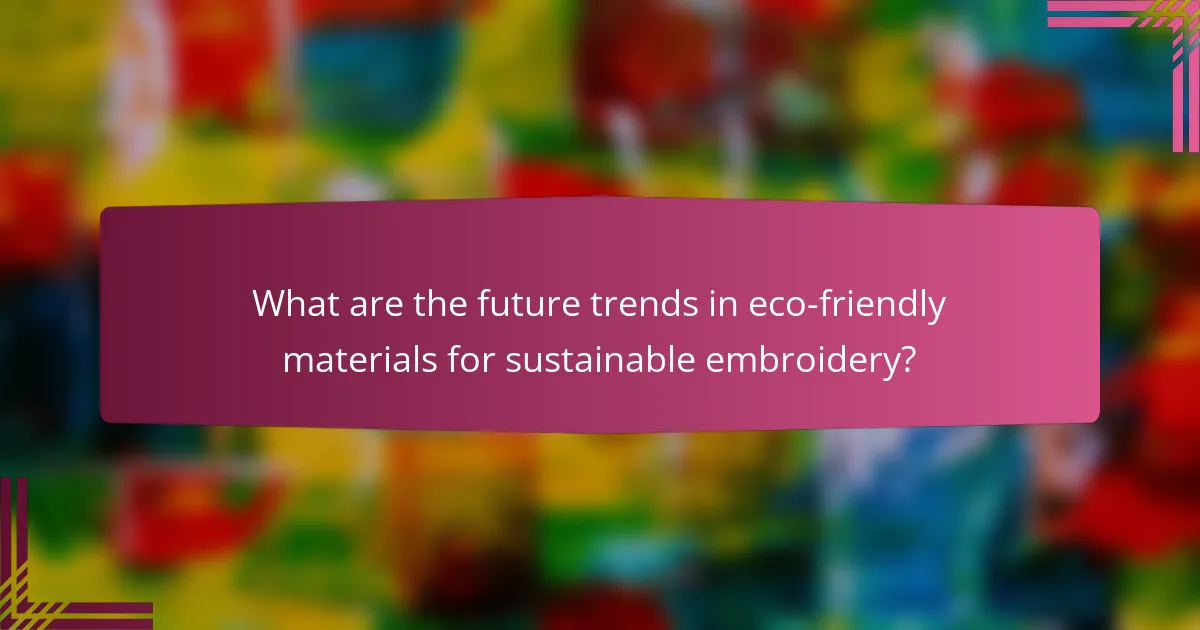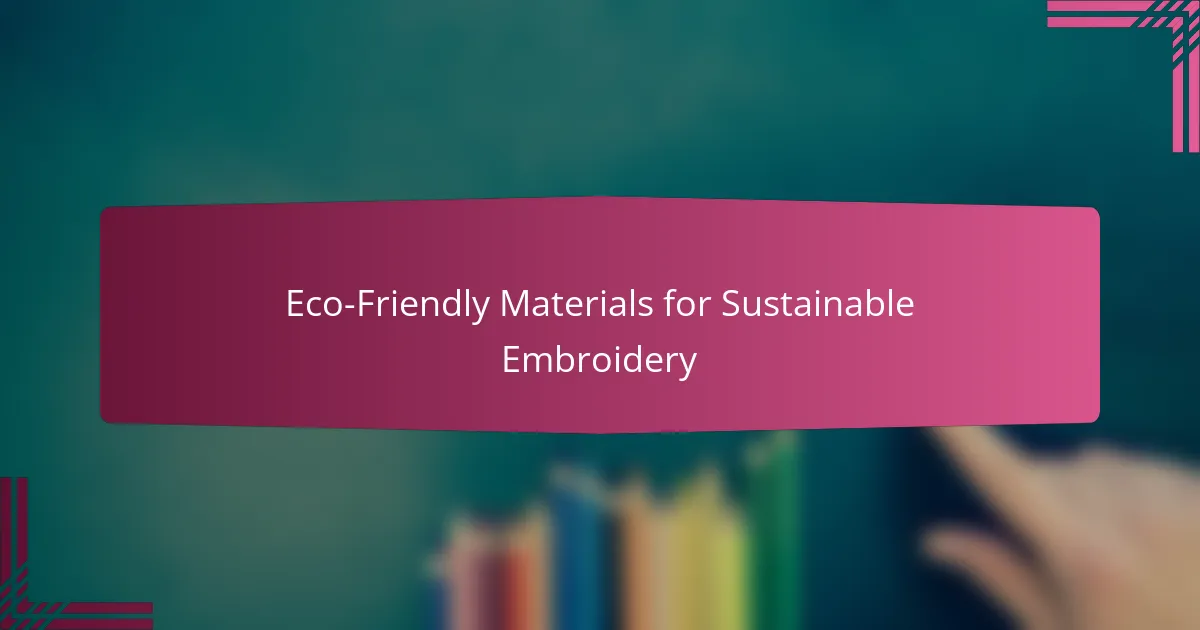
What are Eco-Friendly Materials for Sustainable Embroidery?
Eco-friendly materials for sustainable embroidery include organic cotton, recycled polyester, and bamboo fabric. Organic cotton is grown without synthetic pesticides or fertilizers, reducing environmental impact. Recycled polyester is made from post-consumer plastic bottles, diverting waste from landfills. Bamboo fabric is biodegradable and requires less water and pesticides compared to conventional cotton. These materials contribute to reducing carbon footprint and promoting sustainability in the textile industry.
Why are eco-friendly materials important in embroidery?
Eco-friendly materials are important in embroidery because they reduce environmental impact. Traditional materials often involve harmful chemicals and non-biodegradable substances. Eco-friendly options, such as organic cotton or recycled polyester, minimize pollution and waste. Using these materials supports sustainable practices in the textile industry. Additionally, eco-friendly materials often have a lower carbon footprint. This aligns with growing consumer demand for sustainable products. Studies show that consumers are willing to pay more for eco-friendly options. This trend encourages brands to adopt sustainable materials in their embroidery processes.
What environmental impacts do traditional embroidery materials have?
Traditional embroidery materials can have significant environmental impacts. Common materials like cotton, silk, and synthetic fibers often require extensive agricultural practices. Cotton cultivation uses large amounts of water and pesticides, contributing to water scarcity and soil degradation. Silk production involves raising silkworms, which can disrupt local ecosystems. Synthetic fibers, derived from petroleum, contribute to plastic pollution and are non-biodegradable. The dyeing processes for these materials often involve toxic chemicals, leading to water pollution. Research indicates that textile production is responsible for 20% of global wastewater. Therefore, traditional embroidery materials can harm the environment through resource depletion, pollution, and ecosystem disruption.
How do eco-friendly materials mitigate these impacts?
Eco-friendly materials mitigate environmental impacts by reducing waste and pollution. They are often made from renewable resources, which decreases reliance on finite materials. For instance, organic cotton uses less water and avoids harmful pesticides. Biodegradable fabrics break down naturally, minimizing landfill contributions. Recycled materials repurpose existing waste, lowering the demand for new resources. Studies show that using eco-friendly textiles can reduce carbon emissions by up to 50%. This shift not only conserves natural resources but also promotes sustainable manufacturing practices.
What types of eco-friendly materials are commonly used in sustainable embroidery?
Common eco-friendly materials used in sustainable embroidery include organic cotton, linen, hemp, and recycled polyester. Organic cotton is grown without synthetic pesticides and fertilizers, promoting healthier soil and ecosystems. Linen, derived from the flax plant, requires less water and chemicals during production. Hemp is a robust plant that grows quickly and enriches the soil. Recycled polyester is made from post-consumer plastic bottles, reducing waste and conserving resources. These materials collectively contribute to a lower environmental impact in the embroidery industry.
What are the characteristics of organic cotton?
Organic cotton is a natural fiber grown without synthetic pesticides or fertilizers. It is cultivated using methods that maintain soil health and biodiversity. Organic cotton is softer and more breathable than conventional cotton. It is also hypoallergenic, making it suitable for sensitive skin. The production process of organic cotton uses less water compared to conventional methods. Additionally, organic cotton farming supports sustainable agricultural practices. According to the Global Organic Textile Standard, organic cotton must meet strict environmental and social criteria. This ensures that the cotton is produced in a way that is environmentally friendly and socially responsible.
How does bamboo fabric contribute to sustainability?
Bamboo fabric contributes to sustainability by being a renewable resource. Bamboo grows rapidly, reaching maturity in three to five years. It requires minimal water and no pesticides during cultivation. This reduces environmental impact compared to conventional cotton. Additionally, bamboo fabric is biodegradable, breaking down naturally without harming ecosystems. Its production process generally consumes less energy than synthetic fibers. Bamboo also has natural antibacterial properties, reducing the need for chemical treatments. These attributes collectively support eco-friendly practices in the textile industry.
What role do recycled materials play in eco-friendly embroidery?
Recycled materials play a crucial role in eco-friendly embroidery by reducing waste and conserving resources. These materials often come from post-consumer or post-industrial sources. Utilizing recycled fabrics minimizes the need for virgin materials, which can be resource-intensive to produce. Additionally, using recycled threads and fabrics can lower the carbon footprint associated with the embroidery process. Studies show that incorporating recycled content can significantly decrease environmental impact. For example, using recycled polyester can reduce energy consumption by up to 75% compared to traditional polyester production. This approach not only promotes sustainability but also encourages a circular economy in the textile industry.
How can eco-friendly materials enhance the quality of embroidery?
Eco-friendly materials can enhance the quality of embroidery by providing superior durability and color retention. These materials, like organic cotton and recycled polyester, are often free from harmful chemicals. This results in a softer texture that improves the overall feel of embroidered items. Additionally, eco-friendly threads are less likely to fray, ensuring cleaner stitching. Studies show that organic fabrics can withstand multiple washes without losing vibrancy. This longevity contributes to the overall quality of the finished product. Furthermore, using sustainable materials promotes ethical practices in the textile industry. This can lead to increased consumer trust and brand loyalty.
What are the durability benefits of using sustainable fabrics?
Sustainable fabrics offer enhanced durability benefits compared to conventional materials. They are often made from high-quality, natural fibers that can withstand wear and tear. For instance, organic cotton and hemp have a stronger fiber structure, making them more resilient. Additionally, sustainable fabrics are typically produced with less harmful chemicals, which can weaken fibers over time. Research shows that garments made from sustainable materials can last up to 50% longer than those made from traditional fabrics. This longevity reduces the need for frequent replacements, contributing to a more sustainable fashion cycle.
How do eco-friendly threads affect the overall aesthetic of embroidered designs?
Eco-friendly threads enhance the overall aesthetic of embroidered designs by providing vibrant colors and unique textures. These threads are often made from natural fibers like organic cotton or recycled materials. Such materials can create a softer, more organic look compared to conventional synthetic threads. Eco-friendly threads also tend to have a matte finish, which can give designs a more understated elegance. Additionally, the use of sustainable materials aligns with contemporary design trends that prioritize environmental consciousness. This aesthetic appeal can attract consumers who value sustainability in fashion and home decor. The integration of eco-friendly threads can elevate the visual impact of embroidery while promoting an eco-conscious message.

What are the challenges of using eco-friendly materials in embroidery?
The challenges of using eco-friendly materials in embroidery include limited availability and higher costs. Eco-friendly materials often have a smaller market presence compared to conventional options. This scarcity can lead to difficulties in sourcing specific types of fabrics or threads. Additionally, eco-friendly materials may require specialized techniques for embroidery. These techniques can differ from standard practices, necessitating additional training for artisans.
Quality and performance can also be inconsistent. Some eco-friendly materials may not hold up as well over time, affecting the durability of the final product. Furthermore, there is often a lack of awareness among consumers regarding the benefits of eco-friendly options. This can result in lower demand, making it challenging for manufacturers to justify the costs associated with sustainable materials.
What limitations do eco-friendly materials present to embroiderers?
Eco-friendly materials present several limitations to embroiderers. These materials often have different textures and weights compared to traditional fabrics. This can affect the quality and precision of embroidery. Additionally, eco-friendly threads may have lower tensile strength. This can lead to breakage during the embroidery process. Some eco-friendly materials may also be less colorfast. This can result in fading or bleeding of colors over time. Furthermore, the availability of eco-friendly options can be limited. This reduces the choices for embroiderers seeking sustainable alternatives. Finally, eco-friendly materials may require different care instructions. This can complicate the maintenance of finished products.
How do cost factors influence the choice of eco-friendly materials?
Cost factors significantly influence the choice of eco-friendly materials. Higher costs of sustainable materials can deter manufacturers from using them. Budget constraints often lead to prioritizing cheaper, less sustainable options. Additionally, the initial investment in eco-friendly materials may be offset by long-term savings in energy and waste reduction. Research indicates that 60% of companies cite cost as a primary barrier to adopting sustainable practices. Therefore, balancing cost with environmental benefits is crucial for decision-making in sustainable embroidery.
What technical challenges arise when working with sustainable fabrics?
Sustainable fabrics present several technical challenges. One major issue is the variability in fiber quality. Sustainable fibers often come from diverse sources, leading to inconsistent characteristics. Another challenge is the dyeing process. Many sustainable fabrics require eco-friendly dyes, which can be less colorfast than conventional dyes. This affects the durability of the final product.
Additionally, sustainable fabrics may have different handling properties. For instance, they can be more prone to wrinkling or shrinking. This complicates the manufacturing process. Finally, the cost of sustainable materials can be higher. This impacts pricing strategies and market competitiveness.
How can these challenges be overcome?
Challenges in eco-friendly materials for sustainable embroidery can be overcome through innovative sourcing and technology. Utilizing organic and recycled fibers reduces environmental impact. Implementing sustainable dyeing techniques minimizes water and chemical usage. Collaboration with local artisans promotes community engagement and supports traditional practices. Education on sustainable practices enhances awareness among consumers and manufacturers. Research indicates that sustainable materials can reduce carbon footprints significantly. For instance, organic cotton production uses 91% less water compared to conventional methods. By adopting these strategies, the challenges in sustainable embroidery can be effectively addressed.
What techniques can be employed to work effectively with eco-friendly materials?
Techniques to work effectively with eco-friendly materials include proper selection, preparation, and application methods. Selecting high-quality, sustainable fabrics is essential. Organic cotton and recycled polyester are popular choices. Preparing eco-friendly materials involves pre-washing to remove any chemical residues. This process ensures better dye absorption and fabric performance.
Using water-based inks for printing and dyeing is crucial. These inks are less harmful to the environment and provide vibrant colors. Employing low-energy techniques, like air drying, conserves resources. Hand embroidery techniques can also reduce energy use compared to machine methods.
Lastly, maintaining tools and equipment ensures longevity and efficiency. Regular maintenance reduces waste and promotes sustainable practices in the long term.
How can embroiderers source high-quality eco-friendly materials?
Embroiderers can source high-quality eco-friendly materials by researching suppliers that specialize in sustainable fabrics. They should look for companies that offer organic cotton, hemp, or recycled polyester. Certifications like GOTS (Global Organic Textile Standard) indicate high-quality eco-friendly options. Many suppliers provide detailed information about their sourcing practices. Online marketplaces and local fabric stores often carry eco-friendly materials. Networking with other embroiderers can lead to recommendations for reliable sources. Attending trade shows focused on sustainable textiles can also provide valuable contacts.

What are the future trends in eco-friendly materials for sustainable embroidery?
Future trends in eco-friendly materials for sustainable embroidery include the use of organic cotton, recycled polyester, and biodegradable threads. Organic cotton is grown without harmful pesticides, reducing environmental impact. Recycled polyester is made from post-consumer plastic bottles, promoting waste reduction. Biodegradable threads, often made from natural fibers, decompose more easily than synthetic options. Innovations in plant-based dyes are also emerging, offering non-toxic coloring alternatives. Additionally, advancements in 3D printing technology are creating new possibilities for sustainable embroidery designs. These trends reflect a growing commitment to sustainability in the textile industry.
How is technology influencing the development of sustainable embroidery materials?
Technology is significantly influencing the development of sustainable embroidery materials. Innovations in textile engineering enable the creation of biodegradable and recycled fibers. For instance, advancements in biofabrication allow for materials derived from organic sources, such as algae and fungi. These materials reduce reliance on synthetic fibers, which contribute to environmental pollution.
Additionally, digital printing technology minimizes waste by using precise amounts of dye and fabric. This contrasts with traditional methods that often result in excess material. Smart textiles are also emerging, incorporating sensors and materials that can adapt to environmental conditions.
Research conducted by the Textile Research Journal highlights that these technological advancements lead to more efficient production processes. They also promote the use of renewable resources, aligning with sustainability goals in the fashion industry. Overall, technology is transforming the landscape of sustainable embroidery materials by prioritizing eco-friendliness and resource efficiency.
What innovations are emerging in eco-friendly textiles?
Innovations in eco-friendly textiles include the development of biodegradable fabrics and plant-based dyes. Biodegradable fabrics, such as those made from organic cotton and hemp, decompose naturally, reducing landfill waste. Plant-based dyes are derived from natural sources, minimizing toxic chemical use in production. Additionally, recycled fibers from plastic bottles are being repurposed into new textiles. Innovations also include waterless dyeing technologies that significantly reduce water consumption. Companies are exploring the use of mycelium, the root structure of fungi, to create sustainable leather alternatives. These advancements support a circular economy by promoting sustainability in the fashion industry.
How are brands adapting to the demand for sustainable practices?
Brands are adapting to the demand for sustainable practices by integrating eco-friendly materials into their production processes. Many companies are now sourcing organic cotton, recycled polyester, and biodegradable fabrics. This shift reduces environmental impact and promotes responsible consumption. Brands are also implementing transparent supply chains to ensure sustainability. For instance, some have adopted certifications like GOTS (Global Organic Textile Standard) to validate their claims. Additionally, brands are investing in sustainable technologies, such as water-saving dyeing techniques. This adaptation not only meets consumer demand but also aligns with global sustainability goals.
What are practical tips for incorporating eco-friendly materials into embroidery projects?
Use organic cotton or linen as fabric choices in embroidery projects. These materials are grown without harmful pesticides and chemicals. Opt for natural dyes made from plants or minerals for coloring threads. This reduces the environmental impact compared to synthetic dyes. Choose recycled or upcycled fabrics to create unique designs while minimizing waste. Incorporate biodegradable threads like those made from bamboo or hemp. These threads break down naturally at the end of their life cycle. Consider using water-based adhesives instead of traditional ones. Water-based options are less harmful to the environment. Lastly, support brands that prioritize sustainability in their products. This encourages the industry to shift towards eco-friendly practices.
How can beginners start using eco-friendly materials effectively?
Beginners can start using eco-friendly materials effectively by selecting sustainable fabrics like organic cotton or hemp. These materials reduce environmental impact due to their natural growth processes. Additionally, beginners should prioritize non-toxic dyes and eco-friendly threads. This ensures that the entire embroidery process remains sustainable. Research shows that organic cotton uses 91% less water than conventional cotton. Beginners can also source local materials to minimize transportation emissions. Engaging in upcycling practices, like using scraps from previous projects, further enhances sustainability. By following these steps, beginners can contribute to eco-friendly practices in embroidery.
What resources are available for learning about sustainable embroidery practices?
Resources for learning about sustainable embroidery practices include online courses, books, and workshops. Websites like Skillshare and Udemy offer courses on eco-friendly embroidery techniques. Books such as “The Sustainable Fashion Handbook” by Sandy Black provide insights into sustainable practices. Local craft stores often host workshops focused on sustainable embroidery. Online forums and social media groups also serve as platforms for sharing knowledge and experiences. Additionally, organizations like the Textile Exchange offer resources and guidelines for sustainable textile practices. These resources collectively enhance understanding and implementation of sustainable embroidery methods.
Eco-friendly materials for sustainable embroidery include organic cotton, recycled polyester, and bamboo fabric, which collectively contribute to reducing environmental impact in the textile industry. The article explores the importance of these materials in minimizing pollution, waste, and carbon footprints compared to traditional embroidery materials. It discusses the characteristics, benefits, and challenges associated with eco-friendly fabrics, as well as techniques for effectively incorporating them into embroidery projects. Additionally, it highlights future trends and innovations in sustainable textiles, emphasizing the growing demand for environmentally conscious practices in the fashion industry.
